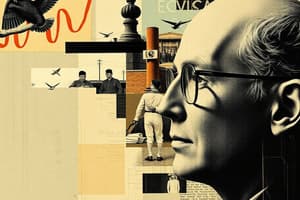Podcast
Questions and Answers
What do Keynesian economists believe about macroeconomic policies?
What do Keynesian economists believe about macroeconomic policies?
They call themselves the 'new Keynesian' and emphasize the inflexibility of wages and prices, recommending activist government macroeconomic policies for economic growth.
What does the Keynesian model assume?
What does the Keynesian model assume?
Prices are constant and changes in aggregate spending determine equilibrium real GDP.
What does the fixed price Keynesian model graph show?
What does the fixed price Keynesian model graph show?
The aggregate supply curve is a horizontal line at fixed price levels, and changes in aggregate demand affect real GDP without changes in price level.
How do modern Keynesians view the aggregate supply curve?
How do modern Keynesians view the aggregate supply curve?
What is Keynesian economics?
What is Keynesian economics?
What do New Keynesians believe about wages and prices?
What do New Keynesians believe about wages and prices?
What role do Keynesians believe the government should play in achieving equilibrium?
What role do Keynesians believe the government should play in achieving equilibrium?
What does monetarist economics emphasize?
What does monetarist economics emphasize?
How do monetarists believe changes in the money supply affect the economy?
How do monetarists believe changes in the money supply affect the economy?
What do monetarists believe about the effects of monetary policy?
What do monetarists believe about the effects of monetary policy?
What role do monetarists believe the government should play in the economy?
What role do monetarists believe the government should play in the economy?
Why do monetarists argue against aggressive economic policies?
Why do monetarists argue against aggressive economic policies?
What kind of rules do monetarists believe the government should set?
What kind of rules do monetarists believe the government should set?
What is classical economics?
What is classical economics?
What does the classical model graph illustrate?
What does the classical model graph illustrate?
What do new classical economists believe about changes in real GDP?
What do new classical economists believe about changes in real GDP?
What role do new classical economists believe the government should have in the economy?
What role do new classical economists believe the government should have in the economy?
What influence do economic theories have on government policy?
What influence do economic theories have on government policy?
What major source of problems do new Keynesians identify?
What major source of problems do new Keynesians identify?
According to monetarists, what is the major source of economic problems?
According to monetarists, what is the major source of economic problems?
What do new classical economists identify as the major source of problems?
What do new classical economists identify as the major source of problems?
Flashcards are hidden until you start studying
Study Notes
Key Concepts in Macroeconomic Theories
-
New Keynesian Economics
- Advocates active government macroeconomic policy to promote economic growth.
- Emphasizes wage and price rigidity, leading to potential unemployment without intervention.
- Role of government is crucial to counterbalance shifts in private sector aggregate demand.
-
Keynesian Model Assumptions
- Assumes prices are constant and that changes in aggregate spending directly influence equilibrium GDP.
-
Aggregate Supply Curves
- Fixed Price Keynesian Model features a horizontal aggregate supply curve, indicating no price level changes with shifts in aggregate demand.
- Modern Keynesian view holds that aggregate supply is horizontal at low GDP levels but becomes positively sloped as output increases, reflecting increasing inflationary pressures.
Economic Schools of Thought
-
Keynesian Economics
- Highlights the necessity of government involvement in stabilizing the economy by managing aggregate demand.
-
Monetarist Economics
- Believes changes in the money supply significantly impact overall economic activity, affecting GDP and price levels.
- Emphasizes that monetary policy has only short-term effects on real GDP, with long-term changes reflected in price level adjustments.
-
Classical Economics
- Argues that real GDP is determined by aggregate supply, while price levels are influenced by aggregate demand.
- Operates under the assumption of perfect wage and price flexibility.
-
New Classical Economics
- Views real GDP changes as a result of unexpected price level variations, maintaining that markets generally operate at equilibrium.
- Rejects government intervention unless policies are unexpected, favoring stable, predictable monetary policies.
Government Roles in Economic Stability
-
Keynesian Perspective
- Government should actively address shifts in aggregate demand to prevent recession; monetary and fiscal policies should intervene during inflationary pressures.
-
Monetarist Perspective
- Advocates for minimal intervention, asserting that the economy can self-correct without government involvement; emphasizes fixed monetary rules instead of discretionary policies.
-
New Classical Perspective
- Suggests that predictable government policies can foster long-term economic stability; however, warns against active manipulation of aggregate demand, which can disrupt equilibrium.
Historical Context and Evolution of Theories
- Economic theories have adapted in response to historical performance and the shortcomings of existing models.
- The proliferation of new models stems from failures of older theories to adequately address contemporary economic challenges.
Influences on Government Policy
- Keynes’ theories spurred widespread adoption of activist fiscal policies.
- Monetarist views encouraged the Federal Reserve to focus on money growth targets over interest rate controls.
- New Classical theories emphasize the importance of clear communication from policymakers to help individuals set future economic expectations.
Summary of Major Approaches
-
New Keynesian
- Sees disequilibrium in labor and goods markets as a key concern; advocates for active management of economic policies.
-
Monetarist
- Attributes problems to discretionary government policies affecting aggregate demand; promotes the necessity of adhering to consistent monetary growth rules.
-
New Classical
- Identifies government attempts to manipulate aggregate demand as problematic; supports the need for stable fiscal and monetary policies for long-term economic health.
Studying That Suits You
Use AI to generate personalized quizzes and flashcards to suit your learning preferences.




